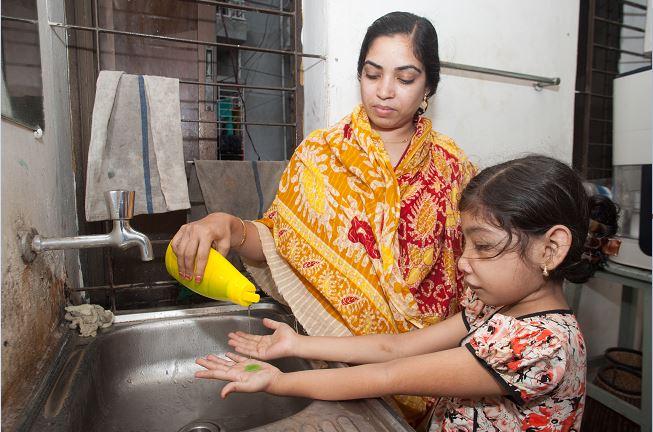November 9, 2017
By Ashley Latimer, Senior Policy & Advocacy Officer at PATH.

The concept of bacteria, viruses, and pathogens is pretty confusing, especially for children. To a child, if your hands aren’t covered in dirt, paint, or food, they’re clean, right? So how do you explain that invisible little pathogens cover every surface and some of those pathogens can cause very serious, sometimes deadly diseases? Children are visual learners—they have to see to believe.
I recently heard about an experiment that grade school teachers carried out to make this exact point to their students; just because you don’t see the germs doesn’t mean they aren’t there. The basic premise is that you take three pieces of regular sandwich bread. One serves as the control—with a pair of sterile gloves or tongs, one piece of bread goes straight into a sealable plastic bag. Next, everyone washes his/her hands with soap, scrubbing, and warm water—correct handwashing technique—and each person passes around a second piece of bread. This bread then goes into its own sealable plastic bag. Lastly, the true test: after a few hours of play, perhaps using the bathroom too, each person touches the third and final piece of bread; no handwashing this time. This bread also goes into its own sealable bag and the experiment begins.
Surely I don’t have to tell you the final results: after a couple of weeks (perhaps sooner in a warm, humid climate), the third piece of bread is covered in mold. Green mold, brown mold, maybe even little yellow mold spots. It is a piece of bread no one would dare eat or even touch. Yet it makes a clear point: those invisible bacteria grow into visible mold, rendering the bread inedible. Even worse, if those bacteria or other pathogens are ingested, they can cause serious illnesses, among them potentially typhoid, cholera, rotavirus, Shigella, and even hepatitis A and E.
The concept of bacteria, viruses, and germs covering ordinary surfaces in our daily lives isn’t something we think about too often, but we should. This Global Handwashing Day, I am reminded of the importance of clean hands to prevent the spread of diseases, especially typhoid.
Typhoid still affects nearly 12 million people a year, killing more than 128,000. It is caused by ingesting bacteria through contaminated food or water, usually due to unsafe water, inadequate sanitation, or poor hygiene habits. We know handwashing is a crucial part of integrated prevention and control solutions that can keep children and adults safe from typhoid and help prevent its spread. In fact, when combined with access to clean, safe water and improved sanitation, handwashing is a core prevention strategy for many diseases. Add in typhoid conjugate vaccines, and it’s an integrated approach that can stop typhoid in its tracks.
Admittedly, many of the children who participate in the moldy bread experiment may not be at risk of exposure to typhoid. However, the point is no less valid: whether a schoolchild in Washington, DC, Lilongwe, or Dhaka, handwashing is imperative. Children, parents, caregivers, teachers, health care workers—all of us—can do our part to limit disease transmission by washing our hands. This Global Handwashing Day, help us take on typhoid by spreading the word about the importance of handwashing. And while you’re at it, mention the benefits of safe water, sanitation, and vaccines, too, so all of our children grow up to be believers.
Editor’s note: This article was originally published by Take on Typhoid to commemorate Global Handwashing Day. We’re sharing it to continue the momentum as its message is still relevant in preventing typhoid today, and everyday, through handwashing with soap.
Subscribe to our mailing list to receive regular updates from the Global Handwashing Partnership or follow us on social media.
© 2017 The Global Handwashing Partnership (GHP).